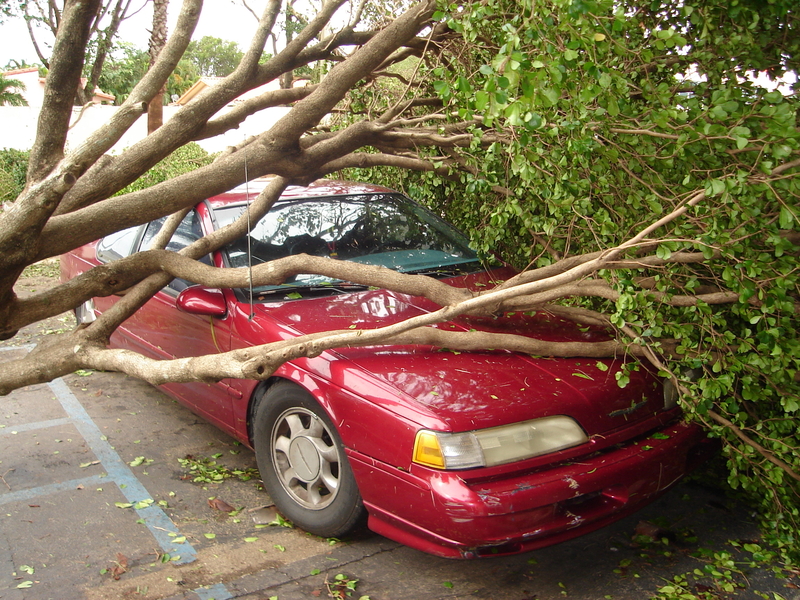Car care tips after severe weather strikes

Severe weather storms such as the heavy rains in Northern California or Hurricane Sandy on the East Coast create special problems for all vehicles.
What should vehicle owners do once the storm is over?
“The first thing you should do is walk around your vehicle and inspect it for any obvious damage,” said Tony Molla, Vice President of Communications for the National Institute for Automotive Service Excellence (ASE). “Obvious damage would be broken lights, cracked lenses, mostly damage on the body of your vehicle.”
Molla also advises contacting your insurance company as another first step following a severe storm or extreme weather conditions, and double-checking your policy. Let your insurance provider know the event that transpired, and get details about the coverage on your policy. Once you know what will and will not be covered, it’s on to the inspection.
A walk around the vehicle is a simple, easy step to assess obvious damage to the outside of the vehicle. Inspecting the inside is another story.
“The most common cause of damage in severe weather situations is flood damage,” said Molla. “If a vehicle is submerged in a high-enough level of water, it can seep into the interior of the vehicle as well as the inner-workings of the automobile.”
While high-wind situations generate their own problems (flying debris, dirt and dust kicked up into the car), water is the most prevalent and common source of damage in weather-related incidents. Notably: floodwater.
Not only is floodwater a problem for your vehicle, the type of water your vehicle is saturated with can have an effect on the outcome of your inspection.
For example, saltwater is more dangerous to a vehicle than freshwater, as the added sodium allows for more build-up in lubrication systems and inner-workings of the vehicle. While freshwater is better than saltwater in that regard, freshwater can still infiltrate the interior and short the electrical system. Contaminated water (like the water surging through lower Manhattan during Sandy) can be the worst of all.
“Water that has been contaminated by sewage or industrial chemicals may contain highly dangerous toxins and material that can be hazardous for human life,” said Molla.
After your thorough inspection of the vehicle’s outside, it’s probably time to call in the experts. Molla advises folks suspecting water damage to allow their vehicles be inspected and repaired by dealership professionals who are trained to efficiently handle such types of vehicle damage. Some water damage can be easy to spot: soaked seats, floor mats, floors, and side-panel stains/rot from water are all visible to the eye. More often than not however, it’s the places car owners do not see that wind up decommissioning the vehicle.
Water and general damage that targets the interior and mechanics or electrical system of a vehicle can be nearly impossible to detect by individuals not well-rehearsed in vehicle inspection and repairs. Water that has managed to soak into the floor and floor mats can be dried out with a blow dryer or replaced with aftermarket floor mats - but without a professional inspection, there is no surefire way to determine the extent of the damage.
Automotive dealerships with full-service crews have the personnel and experience to successfully diagnose and resolve a vast array of vehicle damage issues. Your local dealership service technician can ensure your vehicle’s severe-weather damage has been identified and handled the right way - keeping you and your car on the road safer, longer and with peace-of-mind.
Key points to remember when your vehicle is involved in a significant weather event that might have exposed it to obvious physical damage or water:
• Contact your insurance company - Simply letting your insurance company know that your vehicle has been through severe weather that included flooding/flying debris and inquiring about the details of your policy could save you money on repair costs.
• Inspect the vehicle with a walk around - A walk-around inspection of the exterior of your vehicle following a storm or severe weather can give you an accurate gauge of the extent of body damage and cosmetic blemishes on the vehicle. Simply taking time to inspect the doors, mirrors, glass, lights/lamps, tires and molding gives you a good idea of what you’ll need to fix. Additionally, flood damage can sometimes be identified from the outside.
• Identify the type of damage - Water damage from flooding is not an accurate enough description. Was this freshwater? Saltwater? Contaminated water? It’s crucial to know as much information about the causes of damage, as it is the damage itself.
• Enlist a professional - If you’ve identified flood damage of any kind within your vehicle (or are not sure if your car’s damp floor qualifies as “flood damage”) get a second opinion. Preferably from your dealership and its ASE-certified professional technicians.
Brandon Anicich is a contributor for Sensible Driver.